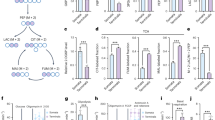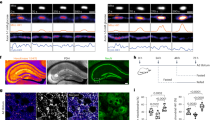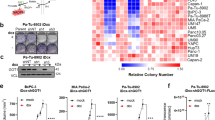Abstract
Neurons and cancer cells use glucose extensively, yet the precise advantage of this adaptation remains unclear. These two seemingly disparate cell types also show an increased regulation of the apoptotic pathway, which allows for their long-term survival1. Here we show that both neurons and cancer cells strictly inhibit cytochrome c-mediated apoptosis by a mechanism dependent on glucose metabolism. We report that the pro-apoptotic activity of cytochrome c is influenced by its redox state and that increases in reactive oxygen species (ROS) following an apoptotic insult lead to the oxidation and activation of cytochrome c. In healthy neurons and cancer cells, however, cytochrome c is reduced and held inactive by intracellular glutathione (GSH), generated as a result of glucose metabolism by the pentose phosphate pathway. These results uncover a striking similarity in apoptosis regulation between neurons and cancer cells and provide insight into an adaptive advantage offered by the Warburg effect for cancer cell evasion of apoptosis and for long-term neuronal survival.
This is a preview of subscription content, access via your institution
Access options
Subscribe to this journal
Receive 12 print issues and online access
$209.00 per year
only $17.42 per issue
Buy this article
- Purchase on SpringerLink
- Instant access to full article PDF
Prices may be subject to local taxes which are calculated during checkout




Similar content being viewed by others
References
Wright, K.M. & Deshmukh, M. Restricting apoptosis for postmitotic cell survival and its relevance to cancer. Cell Cycle 5, 1616–1620 (2006).
Yuan, J. & Yankner, B.A. Apoptosis in the nervous system. Nature 407, 802–809 (2000).
Green, D.R. & Evan, G.I. A matter of life and death. Cancer Cell 1, 19–30 (2002).
Wang, X. The expanding role of mitochondria in apoptosis. Genes Dev. 15, 2922–2933 (2001).
Schubert, D. Glucose metabolism and Alzheimer's disease. Ageing Res. Rev. 4, 240–257 (2005).
Warburg, O. On the origin of cancer cells. Science 123, 309–314 (1956).
Esposti, M.D. The roles of Bid. Apoptosis 7, 433–440 (2002).
Potts, P.R., Singh, S., Knezek, M., Thompson, C.B. & Deshmukh, M. Critical function of endogenous XIAP in regulating caspase activation during sympathetic neuronal apoptosis. J. Cell Biol. 163, 789–799 (2003).
Deshmukh, M., Kuida, K. & Johnson, E.M. Jr., Caspase inhibition extends the commitment to neuronal death beyond cytochrome c release to the point of mitochondrial depolarization. J. Cell Biol. 150, 131–143 (2000).
Neame, S.J., Rubin, L.L. & Philpott, K.L. Blocking cytochrome c activity within intact neurons inhibits apoptosis. J. Cell Biol. 142, 1583–1593 (1998).
Vaughn, A.E. & Deshmukh, M. Essential postmitochondrial function of p53 uncovered in DNA damage-induced apoptosis in neurons. Cell Death Differ. 14, 973–981 (2007).
Yang, J. et al. Prevention of apoptosis by Bcl-2: release of cytochrome c from mitochondria blocked. Science 275, 1129–1132 (1997).
Hancock, J.T., Desikan, R. & Neill, S.J. Does the redox status of cytochrome C act as a fail-safe mechanism in the regulation of programmed cell death? Free Radic. Biol. Med. 31, 697–703 (2001).
Pan, Z., Voehringer, D.W. & Meyn, R.E. Analysis of redox regulation of cytochrome c-induced apoptosis in a cell-free system. Cell Death Differ. 6, 683–688 (1999).
Suto, D., Sato, K., Ohba, Y., Yoshimura, T. & Fujii, J. Suppression of the pro-apoptotic function of cytochrome c by singlet oxygen via a haem redox state-independent mechanism. Biochem. J. 392, 399–406 (2005).
Hampton, M.B., Zhivotovsky, B., Slater, A.F., Burgess, D.H. & Orrenius, S. Importance of the redox state of cytochrome c during caspase activation in cytosolic extracts. Biochem. J. 329, 95–99 (1998).
Kluck, R.M. et al. Cytochrome c activation of CPP32-like proteolysis plays a critical role in a Xenopus cell-free apoptosis system. EMBO J. 16, 4639–4649 (1997).
Borutaite, V. & Brown, G.C. Mitochondrial regulation of caspase activation by cytochrome oxidase and tetramethylphenylenediamine via cytosolic cytochrome c redox state. J. Biol. Chem. 282, 31124–31130 (2007).
Li, M., Wang, A.J. & Xu, J.X. Redox state of cytochrome c regulates cellular ROS and caspase cascade in permeablized cell model. Protein Pept. Lett. 15, 200–205 (2008).
Doyle, D.F. et al. Changing the transition state for protein (Un) folding. Biochemistry 35, 7403–7411 (1996).
Cai, J. & Jones, D.P. Mitochondrial redox signaling during apoptosis. J. Bioenerg. Biomembr. 31, 327–334 (1999).
Kirkland, R.A. & Franklin, J.L. Evidence for redox regulation of cytochrome C release during programmed neuronal death: antioxidant effects of protein synthesis and caspase inhibition. J. Neurosci. 21, 1949–1963 (2001).
Greenlund, L.J., Deckwerth, T.L. & Johnson, E.M. Jr. Superoxide dismutase delays neuronal apoptosis: a role for reactive oxygen species in programmed neuronal death. Neuron 14, 303–315 (1995).
Kaplowitz, N., Aw, T.Y. & Ookhtens, M. The regulation of hepatic glutathione. Annu Rev. Pharmacol. Toxicol. 25, 715–744 (1985).
Verhagen, A.M. & Vaux, D.L. Cell death regulation by the mammalian IAP antagonist Diablo/Smac. Apoptosis 7, 163–166 (2002).
Bensaad, K. et al. TIGAR, a p53-inducible regulator of glycolysis and apoptosis. Cell 126, 107–120 (2006).
Kuo, W., Lin, J. & Tang, T.K. Human glucose-6-phosphate dehydrogenase (G6PD) gene transforms NIH 3T3 cells and induces tumors in nude mice. Int. J. Cancer 85, 857–864 (2000).
Nutt, L.K. et al. Metabolic regulation of oocyte cell death through the CaMKII-mediated phosphorylation of caspase-2. Cell 123, 89–103 (2005).
Deckwerth, T.L. & Johnson, E.M. Jr. Temporal analysis of events associated with programmed cell death (apoptosis) of sympathetic neurons deprived of nerve growth factor. J Cell Biol. 123, 1207–1222 (1993).
Carney, J.M., Smith, C.D., Carney, A.M. & Butterfield, D.A. Aging- and oxygen-induced modifications in brain biochemistry and behavior. Ann. NY Acad. Sci. 738, 44–53 (1994).
Rego, A.C. & Oliveira, C.R. Mitochondrial dysfunction and reactive oxygen species in excitotoxicity and apoptosis: implications for the pathogenesis of neurodegenerative diseases. Neurochem. Res. 28, 1563–1574 (2003).
Tietze, F. Enzymic method for quantitative determination of nanogram amounts of total and oxidized glutathione: applications to mammalian blood and other tissues. Anal. Biochem. 27, 502–522 (1969).
Acknowledgements
We thank Jeffery Rathmell, Gary Pielak, Eugene Johnson and members of the Deshmukh Lab for helpful discussions and critical review of this manuscript. This work was supported by NIH grants NS42197 and GM078366 (to M.D.), NS055486 (to A.E.V.) and by the UNC Cancer Research Fund.
Author information
Authors and Affiliations
Contributions
A.E.V. performed all experiments; A.E.V. and M.D. planned the project and analysed the data.
Corresponding author
Ethics declarations
Competing interests
The authors declare no competing financial interests.
Supplementary information
Supplementary Information
Supplementary Information (PDF 755 kb)
Rights and permissions
About this article
Cite this article
Vaughn, A., Deshmukh, M. Glucose metabolism inhibits apoptosis in neurons and cancer cells by redox inactivation of cytochrome c. Nat Cell Biol 10, 1477–1483 (2008). https://doi.org/10.1038/ncb1807
Received:
Accepted:
Published:
Issue Date:
DOI: https://doi.org/10.1038/ncb1807



